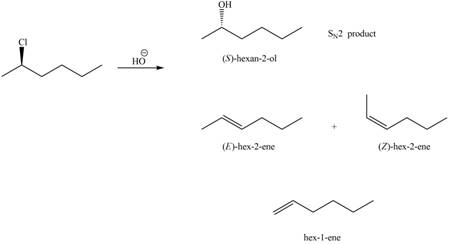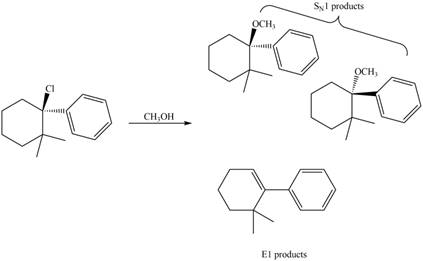
Concept explainers
Draw all products, including stereoisomers, in each reaction.
a. c.
c.
b. d.
d.
(a)
Interpretation: All products formed in the given reaction are to be drawn.
Concept introduction: The one-step bimolecular elimination reaction that favors the removal of a proton by a base from carbon adjacent to the leaving group that results in the formation of a carbocation is termed as
The nucleophilic reaction that consists of bimolecular as well as bond-making and bond-breaking steps is termed as
Stereoisomers have the same molecular formula but they differ in the three-dimensional arrangement of their bonds.
Answer to Problem 8.56P
The products that are formed in the given reaction are
Explanation of Solution
In the given reaction, the secondary alkyl halide is treated with a strong base due to which both substitution and elimination reactions takes place with the given secondary alkyl halide. This reaction results in the formation of three alkenes via

Figure 1
Thus, the products formed in the given reaction are
The products that are formed in the given reaction are
(b)
Interpretation: All products formed in the given reaction are to be drawn.
Concept introduction: The one-step bimolecular elimination reaction that favors the removal of a proton by a base from carbon adjacent to the leaving group that results in the formation of a carbocation is termed as
The nucleophilic reaction that consists of bimolecular as well as bond-making and bond-breaking steps is termed as
Stereoisomers have the same molecular formula but they differ in the three-dimensional arrangement of their bonds.
Answer to Problem 8.56P
The products that are formed in the given reaction are s
Explanation of Solution
In the given reaction, the secondary alkyl halide is treated with a strong base due to which both substitution and elimination reactions takes place with the given secondary alkyl halide. This reaction results in the formation of three alkenes via

Figure 2
Thus, the products formed in the given reaction are s
The products that are formed in the given reaction are s
(c)
Interpretation: All products formed in the given reaction are to be drawn.
Concept introduction: The two-step unimolecular elimination reaction that favors the removal of a HX substituent and the formation of a carbocation intermediate takes place in its first step. In the second step of the reaction, the carbocation forms a double bond. This type of reaction is termed as
The two-step unimolecular reaction which favors the removal of a HX substituent and the formation of a carbocation intermediate takes place in its first step. Then, in the second step, the carbocation undergoes substitution. This type of reaction is termed as
Stereoisomers have the same molecular formula but they differ in the three-dimensional arrangement of their bonds.
Answer to Problem 8.56P
The products that are formed in the given reaction are
Explanation of Solution
The given reaction takes place between the tertiary alkyl halide and methanol that acts as a weak base as well as a weak nucleophile. The given tertiary alkyl halide undergoes elimination reaction via

Figure 3
Thus, the products formed in the given reaction are
The products that are formed in the given reaction are
(d)
Interpretation: All products formed in the given reaction are to be drawn.
Concept introduction: The nucleophilic reaction that consists of bimolecular as well as bond-making and bond-breaking steps is termed as
Stereoisomers have the same molecular formula but they differ in the three-dimensional arrangement of their bonds.
Answer to Problem 8.56P
The product that is formed in the given reaction is shown in Figure 4.
Explanation of Solution
In the given reaction, the secondary alkyl halide is treated with a strong base due to which both substitution and elimination reactions takes place with the given secondary alkyl halide. This reaction results in the formation of three alkenes via

Figure 4
The product that is formed in the given reaction is shown in Figure 4.
Want to see more full solutions like this?
Chapter 8 Solutions
Organic Chemistry
Additional Science Textbook Solutions
Organic Chemistry
General, Organic, & Biological Chemistry
Chemistry For Changing Times (14th Edition)
General Chemistry: Principles and Modern Applications (11th Edition)
Chemistry: Structure and Properties
Chemistry: The Molecular Nature of Matter
- Draw a stepwise mechanism for the following reaction, a key step in the synthesis of conivaptan (trade name Vaprisol), a drug used in the treatment of low sodium levels.arrow_forwardDraw a stepwise mechanism for the following reaction, a key step in the synthesis of conivaptan (trade name Vaprisol), a drug used in the treatment of low sodium levearrow_forwardDraw a stepwise mechanism for the following reaction:arrow_forward
 ChemistryChemistryISBN:9781305957404Author:Steven S. Zumdahl, Susan A. Zumdahl, Donald J. DeCostePublisher:Cengage Learning
ChemistryChemistryISBN:9781305957404Author:Steven S. Zumdahl, Susan A. Zumdahl, Donald J. DeCostePublisher:Cengage Learning ChemistryChemistryISBN:9781259911156Author:Raymond Chang Dr., Jason Overby ProfessorPublisher:McGraw-Hill Education
ChemistryChemistryISBN:9781259911156Author:Raymond Chang Dr., Jason Overby ProfessorPublisher:McGraw-Hill Education Principles of Instrumental AnalysisChemistryISBN:9781305577213Author:Douglas A. Skoog, F. James Holler, Stanley R. CrouchPublisher:Cengage Learning
Principles of Instrumental AnalysisChemistryISBN:9781305577213Author:Douglas A. Skoog, F. James Holler, Stanley R. CrouchPublisher:Cengage Learning Organic ChemistryChemistryISBN:9780078021558Author:Janice Gorzynski Smith Dr.Publisher:McGraw-Hill Education
Organic ChemistryChemistryISBN:9780078021558Author:Janice Gorzynski Smith Dr.Publisher:McGraw-Hill Education Chemistry: Principles and ReactionsChemistryISBN:9781305079373Author:William L. Masterton, Cecile N. HurleyPublisher:Cengage Learning
Chemistry: Principles and ReactionsChemistryISBN:9781305079373Author:William L. Masterton, Cecile N. HurleyPublisher:Cengage Learning Elementary Principles of Chemical Processes, Bind...ChemistryISBN:9781118431221Author:Richard M. Felder, Ronald W. Rousseau, Lisa G. BullardPublisher:WILEY
Elementary Principles of Chemical Processes, Bind...ChemistryISBN:9781118431221Author:Richard M. Felder, Ronald W. Rousseau, Lisa G. BullardPublisher:WILEY





